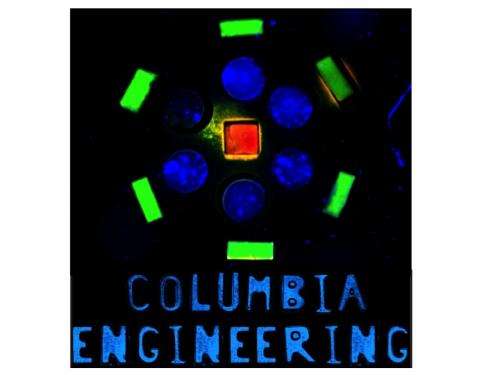Designing interlocking building blocks to create complex tissues: More precise design of tissue architecture

(Medical Xpress)—Researchers at Columbia Engineering have developed a new "plug-and-play" method to assemble complex cell microenvironments that is a scalable, highly precise way to fabricate tissues with any spatial organization or interest—such as those found in the heart or skeleton or vasculature. The study reveals new ways to better mimic the enormous complexity of tissue development, regeneration, and disease, and is published in the March 4 Early Online edition of Proceedings of the National Academy of Sciences (PNAS).
"George Eng, an MD/PhD student in my lab who just received his doctoral degree, designed a lock-and-key technique to build cellular assemblies using a variety of shapes that lock into templates much the way you would use LEGO building blocks," says Gordana Vunjak-Novakovic, who led the study and is the Mikati Foundation Professor of Biomedical Engineering at Columbia Engineering and professor of medical sciences. "What is really important about this technique is that these shapes are tiny—just a fraction of millimeter, the thickness of a human hair—and that their precise arrangements are made using cell-friendly hydrogels."
Tissue cells in the human body form specific architectures that are critical for the function of each tissue. Cardiac cells, for example, are aligned to create maximum force acting in one direction. Cells without specific spatial organization may never become fully functional if they do not recapitulate their intrinsic organization found in the body. The Columbia Engineering technique enables researchers to construct unique and controlled cell patterns that allow precise studies of cell function, so that, Vunjak-Novakovic adds, "we can now ask some of the more complex questions about how the cells respond to the entire context of their environment. This will help us explore cellular behavior during the progression of disease and test the effects of drugs, stem cells, and various other therapeutic measures."
Eng, who is the lead author of the PNAS paper, used computer-chip-fabrication technologies to make micrometer-sized subunits containing living cells and bioactive molecules, in specific building-block geometries, such as cylinders or cubes. Each shape is prepared to have its own unique biological properties and is then placed into its geometrically matching well on the hydrogel template. The assembling technique is simple: a mixture of various types of shapes is pipetted onto a template with a specific arrangement of the matching wells and placed on a laboratory shaker for a few minutes.
Each shape can dock only into its matching well—the rectangular blocks dock only into the exact same rectangular wells, cylindrical blocks into cylindrical wells, and so on, in a lock-and-key manner. After up to ten short cycles of shaking, the template becomes filled with shapes to form a precisely defined pattern. This docking technique thus allows rapid assembly of a large number of subunits to create new tissues.
"We used a LEGO-like lock-and-key docking system to spatially localize different cell populations with high specificity and precision," Eng explains. "And, since each shape is docking independent of each other, large tissues can be organized simultaneously, instead of having to create a sequential, brick-by-brick type of organization. With this method, we can design and create better tissues for potential organ replacement."
"The beauty of this method is that complex configurations of living cellular material— many different types of cells, molecules, and extracellular materials—emerge in the lab in precise three-dimensional geometries in a way that can be used by anyone, as no special equipment is involved," Vunjak-Novakovic adds.
Eng is excited about leveraging the microtechnologies used to make computer chips with biomedical engineering techniques to make cells to fabricate new organs. "We develop new ideas and methods to try and alleviate disease by assembling tiny subunits of cells into larger, more functional organs," he says. "It's really like a scene from science fiction! To be on the frontier of scientific discovery, developing new methods and products that we hope will have therapeutic benefit for people is quite fulfilling and motivating. And there's such an exciting element of discovery in designing new cellular microenvironments, studying the rules that define cell communication and organization."
Next steps in the application of this new technique include fabrication of different types of functional tissues, such as well-organized cardiac muscle, a tissue whose function critically depends on its architecture and cell alignment, incorporating blood vessel networks along with organized cardiac cells. The method will also be extended to the design of pathological microenvironments of interest, such as tumor models.
"Our lab has worked for many years in building 'human-on-a-chip' systems that will allow us to see cellular responses representative of those of whole body physiology," says Vunjak-Novakovic. "We're also very interested in developing technologies that can advance biological experimentation and allow us to ask more complex questions. This study, which was conducted over the last four years, is contributing to both of these areas and helping us advance our methods for screening of therapeutic cells and factors."


















